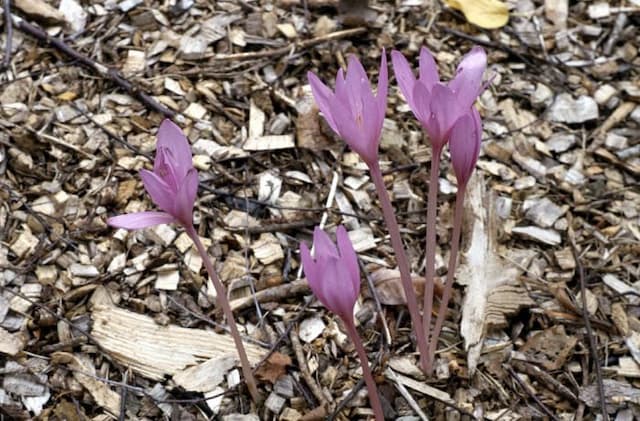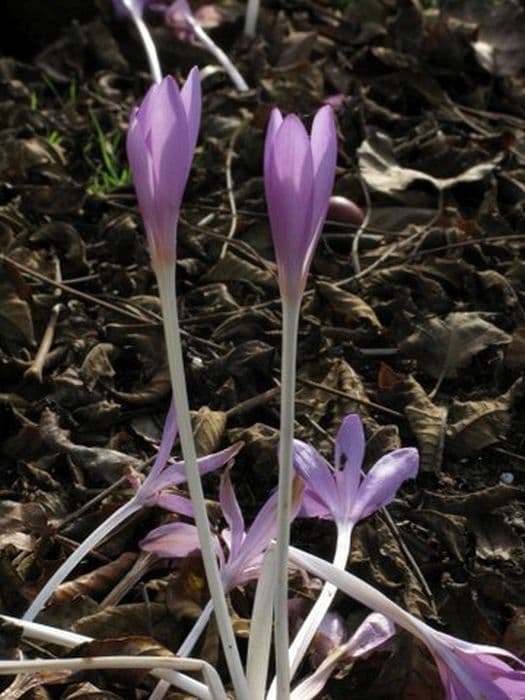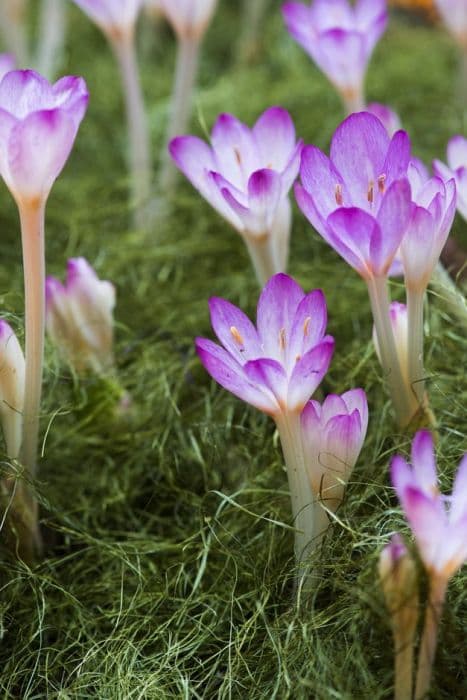Autumn crocus Colchicum 'Dick Trotter'

ABOUT
The Colchicum 'Dick Trotter', commonly known as autumn crocus, is a flowering perennial that exhibits a number of distinctive features. The plant is noted for its vibrant, cup-shaped flowers which have a striking color—usually a deep pink or purple hue. The petals have an elongated, somewhat lance-shaped appearance, and they often display a delicate white throat in the center that contrasts beautifully with the rich color of the rest of the flower. The autumn crocus blooms in the fall, producing singular, showy flowers before the foliage even emerges. The leaves appear later, typically in the spring, and are glossy green in color. They are broad and strap-like, with a smooth texture, providing a lush, green backdrop after the flowering period has concluded. The plant grows from a bulb-like structure, which is actually a corm, a swollen underground plant stem that serves as a storage organ, containing nutrients to support the plant's growth and flowering cycle. After flowering, the autumn crocus goes into a period of dormancy, where the above-ground parts of the plant die back, and it rests until the next growing season. The autumn crocus is often admired in gardens for its timely blossoming, signaling the end of summer and the onset of autumn. Its flowers are one of the few vibrant blooms that can be seen during this time, providing an unexpected splash of color in the garden landscape when many other plants are beginning to fade.
About this plant
 Names
NamesSynonyms
Autumn Crocus, Meadow Saffron
Common names
Colchicum 'Dick Trotter'.
 Toxicity
ToxicityTo humans
Autumn crocus (Colchicum 'Dick Trotter') contains toxic alkaloids, such as colchicine, which can be harmful if ingested. Poisoning symptoms may include gastrointestinal distress like vomiting, diarrhea, abdominal pain, as well as more severe effects like kidney failure, respiratory difficulties, and multiple organ failure. Ingesting any part of the autumn crocus can potentially lead to fatalities if not promptly and properly treated.
To pets
Autumn crocus is toxic to pets due to the presence of colchicine. Symptoms of poisoning in animals include drooling, vomiting, diarrhea, abdominal pain, seizures, and respiratory failure. Ingesting any part of the plant can lead to severe health consequences, including potentially fatal multi-organ failure. Immediate veterinary attention is crucial for pets that have consumed any portion of the autumn crocus.
 Characteristics
CharacteristicsLife cycle
Perennials
Foliage type
Deciduous
Color of leaves
Green
Flower color
Lavender
Height
6 inches (15 cm)
Spread
3 inches (7.5 cm)
Plant type
Bulb
Hardiness zones
4
Native area
Mediterranean
Benefits
 General Benefits
General Benefits- Ornamental Value: Adds visual appeal to gardens with its vibrant purple-pink flowers.
- Seasonal Interest: Blooms in autumn, providing color when most other plants are fading.
- Naturalizing: Capable of spreading and naturalizing in an area, creating larger displays over time.
- Low Maintenance: Requires minimal care once established, making it suitable for busy or novice gardeners.
- Deer and Rodent Resistance: Not typically browsed by deer or damaged by rodents, ensuring its display remains intact.
- Drought Tolerance: Once established, shows resilience in dry conditions, reducing the need for frequent watering.
 Medical Properties
Medical Properties- This plant is not used for medical purposes.
 Air-purifying Qualities
Air-purifying QualitiesThis plant is not specifically known for air purifying qualities.
 Other Uses
Other Uses- Colchicum 'Dick Trotter', commonly known as autumn crocus, can be used as a natural insect repellent in gardens, as its toxic properties may deter pests.
- The bulb-like corms of the autumn crocus can be placed around vulnerable plants to protect against rodent damage, as rodents typically avoid them due to their toxicity.
- The plant's striking flowers can be used for ornamental purposes in floral arrangements when in bloom, albeit with caution due to its toxin content.
- During the off-blooming season, the dried leaves of autumn crocus can be used in crafting, such as in the creation of nature-inspired artwork or bookmarks.
- The autumn crocus is sometimes used in photography projects to illustrate the concept of beauty and danger due to its deceptive appearance and poisonous nature.
- Its vibrant flowers can be used as natural dye sources for fabrics, giving them a unique and potentially long-lasting coloration.
- In historical education settings, autumn crocus may be featured to discuss ancient practices and caveat of using plants in medicine without proper knowledge.
- In alternative fashion, parts of the plant might be included in eco-printing techniques on sustainable garments for a distinctive botanical imprint.
- As a contemplative garden feature, autumn crocus is useful for garden designers seeking to create a space that changes dramatically with the seasons, given its autumnal blooming pattern.
- The plant can be used in species-specific gardens focused on pollinators that can safely interact with autumn crocus, as it provides pollen for certain insects.
Interesting Facts
 Feng Shui
Feng ShuiThe Autumn Crocus is not used in Feng Shui practice.
 Zodiac Sign Compitability
Zodiac Sign CompitabilityThe Autumn Crocus is not used in astrology practice.
 Plant Symbolism
Plant Symbolism- Renewal and Rebirth: Colchicum, commonly known as autumn crocus, often blooms suddenly and vigorously in the fall, symbolizing the idea that life can renew itself or that a new beginning can emerge when it's least expected.
- Endurance: The autumn crocus has the ability to withstand cold temperatures and bloom even as the winter approaches, representing resilience and the ability to endure challenging conditions.
- Beauty and Transience: With its attractive and delicate purple flowers that appear briefly in the autumn, the autumn crocus is a reminder of the transient nature of beauty and life itself.
 Water
WaterColchicum, commonly known as autumn crocus, should be watered moderately during the growing season. Preferably, water when the top inch of soil feels dry to the touch, which may equate to approximately once a week, depending on climate conditions. Since it is a bulb plant, be cautious not to overwater, as this can lead to bulb rot. The amount of water usually ranges from 16 to 32 ounces per watering session. During the dormancy period in summer, watering should be reduced significantly or even stopped altogether to mimic its natural Mediterranean habitat.
 Light
LightAutumn crocus flourishes best in full sunlight to partial shade. Ideally, select a location that receives morning sun and is partially shaded during the hottest part of the afternoon. This ensures that the plant gets enough light without being exposed to excessive heat, which can be detrimental.
 Temperature
TemperatureAutumn crocus prefers moderate temperatures and can survive in a range with a maximum around 70 to 75 degrees Fahrenheit and a minimum of 50 degrees Fahrenheit at night. The ideal temperature for this plant usually holds steady around the mid-60s Fahrenheit. Avoid exposure to temperatures below 50 degrees Fahrenheit, as the plant can be susceptible to cold damage.
 Pruning
PruningPruning for autumn crocus is mainly for aesthetic purposes and involves removing spent flowers and yellowing leaves. The best time to prune is after the flowers have faded and the leaves begin to wither naturally, which is typically in late spring. Pruning too early can hinder the plant's ability to store energy for the next flowering season.
 Cleaning
CleaningAs needed
 Soil
SoilAutumn Crocus thrives well in well-draining soil with a neutral to slightly alkaline pH of 6.0 to 7.5. A good soil mix for this plant would consist of equal parts garden soil, peat moss, and sharp sand or perlite to improve drainage. Adding some bone meal to the mix can provide essential phosphorus for blooming.
 Repotting
RepottingThe Autumn Crocus, also known as 'Dick Trotter', generally doesn't require frequent repotting and can be left undisturbed for several years. It is best to repot or divide the corms when they become overcrowded, typically every 3-4 years to maintain vigor and flower production.
 Humidity & Misting
Humidity & MistingThe Autumn Crocus, commonly referred to as 'Dick Trotter', prefers moderate humidity levels but is relatively adaptable to variations as long as the soil moisture and temperature conditions are suitable.
 Suitable locations
Suitable locationsIndoor
Keep in bright, indirect light and ensure soil is well-drained.
Outdoor
Plant corms in well-draining soil, full sun to part shade.
Hardiness zone
4-9 USDA
 Life cycle
Life cycleAutumn Crocus 'Dick Trotter' begins its life cycle as a corm, which is a storage organ that survives dormant periods. In late summer to autumn, the plant produces its striking, large, goblet-shaped pink to lilac flowers directly from the corm, without any visible foliage. After flowering, the foliage emerges as a rosette of green leaves that photosynthesize and store energy back into the corm throughout the winter and spring. The leaves die back as temperatures rise in early summer, and the plant enters a dormancy period during the hot summer months. In subsequent years, the cycle repeats with the corm producing new flowers each autumn, followed by foliage in the winter-spring, and then dormancy again in summer. Over time, the corm may produce offsets, leading to a clumping growth habit as the plant slowly propagates.
 Propogation
PropogationPropogation time
Spring-Fall
Propogation: The autumn crocus 'Dick Trotter' is typically propagated by dividing its corms, which is best done in the summer after the plant has finished flowering and the foliage has died back. When the corms are dormant, carefully lift them out of the soil with a garden fork, taking care not to damage them. Gently brush off the soil and separate the smaller cormels from the parent corm. These cormels can then be replanted immediately at a depth of around 3 inches (7.6 centimeters) and spaced about 4 to 6 inches (10 to 15 centimeters) apart, ensuring that they are placed in well-draining soil in a location that mimics their natural habitat, typically a spot with full sun to partial shade. By the following fall, these cormels will have matured and can produce flowers. This method of vegetative propagation maintains the unique characteristics of the 'Dick Trotter' cultivar.









